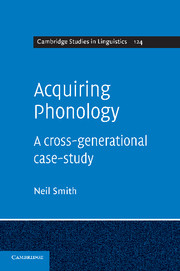7 - Appendices
Published online by Cambridge University Press: 04 August 2010
Summary
Z's cluster production
This appendix documents the ‘clusters’ produced by Z. This simple observation hides a multiplicity of problems, hence the scare quotes. First is the question of systematicity: in the first six stages Z sporadically produced a number of complex articulations (such as [xw]) without these becoming in any way predictable. I have therefore gathered these together in appendix 7.1.1 as ‘sporadic clusters’. Others, of course, may be able to see patterns where I have failed to do so. The second problem is raised by the contrast between clusters and secondary articulations, a problem which becomes particularly acute when these are on a continuum, as in the difference between [ts] and [ts]. Third, the adult target may be either one phoneme or two and it seems slightly odd to characterise the child's realisation of /z/ by [-dz] in please, or of /dʒ-/ by [dr-] in giraffe, as a cluster on a par with his realisation of /dz/ and /dr/ by [dz] and [dr]. None the less, I have generally included here all digraphs even where these are used for a single adult phoneme, except that heavy aspiration (represented by [Ch]) is not treated as instantiating a cluster. Apart from this a superscript typically indicates that the sequence is a secondary articulation rather than a cluster, though this is problematic with e.g. Z's first initial ‘cluster’ [br].
- Type
- Chapter
- Information
- Acquiring PhonologyA Cross-Generational Case-Study, pp. 235 - 248Publisher: Cambridge University PressPrint publication year: 2009

